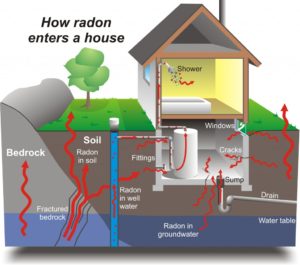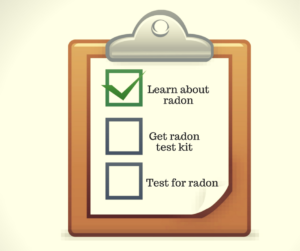 Radon?
Radon?
Yes, that radioactive atom that we are shielded from during X-rays? Actually in Colorado, the geological makeup of our soil puts all 64 counties at high risk for radon seeping into our homes. Fifty percent of homes around the state are thought to have levels above the EPA action level of 4 pCi/L. The average in the state is 6.7 pCi/L and in some mountain communities, significantly higher. So what is radon and what is the risk?
Radon is a naturally occurring radioactive gas resulting from a long term decay process involving granite and shale in our soils. It seeps into our homes in varying concentrations, depending on what the house sits on.
- Long term exposure to radon is the number one cause of lung cancer for never smokers, and the number two cause of lung cancer for cigarette smokers (far beyond second hand smoke). For example, at 4 pCi/L this is equivalent long term to smoking eight cigarettes per day. At 4 pCi/L, 7 of 1,000 never smokers and 62 of 1,000 smokers die of radon related lung cancer in the U.S. Thirteen percent of lung cancer deaths in the US in 2003 were Radon induced. For every 2.7 pCi/L increase in your home’s level, the risk of radon induced lung cancer increases 16%. According to Colorado Department of Health, an estimated 506 people die annually in our state from radon induced lung cancer.
What should you do?
- Start with a simple three day screening test that you can obtain for typically $10-$15. Whether you get your test kit from the hardware store, health department or local CSU Extension office, it should be certified by the National Radon Proficiency Program. Follow the directions provided for the amount of time to expose the testing device in your home, and how and where to mail it for lab results. The goal is to get an initial idea of the amount of radon that is in the breathing spaces of your home. For specific details about pre- and post-testing, visit www.coloradoradon.info.
- If buying or selling a home, requirements to have a home tested or mitigated prior to selling vary by city or county.
- If levels of radon in your home are consistently greater than 4 pCi/L, mitigation by a certified mitigator is recommended.
- Re-testing is recommended since your home and the ground underneath can change over time.
- If your home tests below the action level of 4 pCi/L, re-testing is recommended every five years.
- If your home has a radon mitigation system in place, re-test every two years to make sure it is functioning properly.
The Colorado Department of Health recently adopted a Colorado Cancer Plan Roadmap for healthcare providers for 2016-2020 (https://www.colorado.gov/pacific/sites/default/files/DC_cancer_Colorado-Cancer-Plan-2016-2020.pdf). The roadmap is a plan to reduce cancer in Colorado over the next five years. Lung cancer is ranked number 3 for incidence in Colorado and number one for mortality, though mortality has decreased 24 percent overall in Colorado.
Live smart and learn more about Preventing Radon Problems in the Home. Screening your home for radon is a first step for preventative action. Each home is unique so don’t make presumptions based on neighboring radon test levels. Once the initial three day screening is completed, another test is recommended if results are greater than 4 pCi/L.


Great info Wendy! I appreciated your reminder to test for radon every 2 years if you have a mitigation system. I think too many of us assume ‘if it isn’t broken, don’t worry about it!’ But things can change to a home over time…Do you know if heating with a fireplace insert might negatively affect my radon system? Since the fireplace is creating a draw from the lower level of our home? I don’t think we tested during a time we had the fireplace operating 24/7.
Thank Elisa. I suggest running a short term test to be sure the mitigation system is handling whatever your home needs are. After you get the results, it should help with knowing what might or might not needs to happen. When a family changes heat system or does a significant remodel, it can change airflow and a screening should be done regardless of where you are in the 2 (or 5 year check).
Winter is the perfect time to test your home for radon gas. The short term radon test kits require that you close up your home…we do that naturally in the cold winter months. Great reminder Wendy!
This is a good reminder, thanks Wendy!
Thanks, Wendy! Nice article.